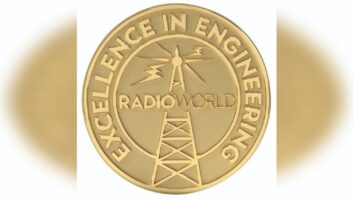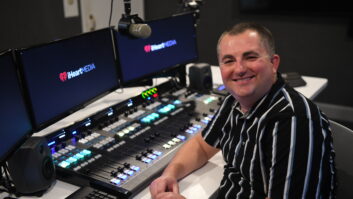
Wayne Pecena suggests that IP networking is the foundation of today’s diverse aspects of information technology.
(Click to Enlarge)
Recent years have seen tremendous changes in IT technology as applied to the radio and TV environments. Whether it’s AoIP for radio or the “channel in a box” for TV, strategic planning and management of information technology can be a wild ride.
RW tapped industry experts Wayne Pecena and Gary Olson for insights into managing and keeping current with information technology.
Pecena is assistant director of Educational Broadcast Services in the Office of Information Technology at Texas A&M University. He is responsible for broadcast technology implementation at KAMU(FM/TV) and is approaching 40 years in the broadcast industry; he is a member of the national board of directors of the Society of Broadcast Engineers and chair of its SBE Education Committee, as well as a member of the Public Broadcast Service Engineering Technical Advisory Committee.
Gary Olson is a technology strategist in the information and communication media technology industries. He is author of a new SBE course “The New Lifecycle of Media — IP and File-based Workflows.” Both are frequent speakers on IT topics.
‘Intermediate’
IT, of course, has gradually taken over the broadcast plant. According to Pecena, the trend typically started in the accounting department, then spread to program log generation and news scripts; now it is fully integrated into the content side.
In radio we see AoIP plants with content delivered in multiple formats to multiple platforms. In the TV environment, it is implemented in multi-channel, multi-stream operations. Engineering tools have evolved along with them. “It started out with remote control, and we’ve moved way past that,” said Pecena. Olson notes as an example that the transition began at ABC in early 2000, when it transitioned from a paper-based to file-based environment.
So broadcast engineers have needed an expanding level of IT literacy. As the level of expertise needed for the job continues to increase, the industry is responding, if slowly.
“When I began doing workshops for the SBE three years ago,” Pecena said, “most attendees described themselves as being in the beginning to intermediate levels. Now most attendees see themselves at the intermediate level and seek more advanced IT knowledge. I still see very few in the advanced category.” He adds that the shift is largely market-driven; even if one wanted to, it would be hard to avoid IT concerns entirely, even in the RF environment.
The evolution of engineers to IT is “a mixed bag,” said Olson. “Most of the traffic on SBE e-mail lists is centered on traditional transmission systems, with less content about IP infrastructure or new streaming systems.”
How should engineers build and maintain IT skills? There are opportunities both formal and informal for education.
Pecena urges engineers not to get too hung up on the need for formal programs, saying they should remember the value of informal education, which “often occurs in conjunction with other events and is experienced in the course of everyday life. It is often spontaneous.”
Formal education may be overly structured, time-consuming and expensive. Pecena said the exam fee for a Cisco Certified Architect is $15,000. He adds there is research to suggest that job performance over time is the result of about 25 percent formal, and 75 percent informal education.
Meanwhile, many skills from the analog days retain their value, Olson says, if with a twist. “Multiple audio editing tools, for example, have been consolidated into a single package — Legos on a screen, if you will. You still need to understand the basics of analog audio: editing, equalizing, processing and filtering; but it works a bit differently in the desktop realm. Therefore, the way you approach problems is different; yet many engineers lack this understanding.”
Both men said the SBE website provides a great deal of information. SBE University offers online/on-demand courses, as well as live and recorded webinars and other materials.
Tech as a tool
Some problems of IT management don’t have easy answers, even for experts. Strategic planning is one.
“It is an ongoing challenge,” said Pecena. “Keeping up with the changes is always difficult. Also, making bad decisions or mistakes can put your career in jeopardy, especially in this economy. The main focus should be how to use technology as a tool to achieve business goals.” This problem, he adds, is not unique to broadcast.
The best strategy for IT managers, he believes, is to retain sight of the big picture. “Many managers get too focused on the technology of IT, and forget that they are part of a business that exists to make money or an organization that delivers a service. Keeping a true business focus will better enable managers to define meaningful goals for their IT departments.”
Another sticky topic in both radio and TV is metadata, a term that is used and abused, according to Olson.
“No one wants to talk about it, but you can’t monetize metadata if you don’t use it well. It needs to be about information that is meaningful to the end user. Once you do that, things get interesting.”
For both radio and TV, a challenge for managers is keeping up with multiple platforms. Laptops, tablets, mobile phones and websites require content with different standards, bit rates and protocols; and these are in a continuous state of flux. For operations with smaller budgets, a decision often has to be made regarding which platforms to support. Olson notes that the way a station packages video for an LCD TV is different than the way it’s done for cell phones.
Meanwhile, and in spite of the attention on new platforms, Pecena notes that in most cases, the majority of the revenue still comes from the RF side of things, but the future certainly looks as the Internet.
And a further challenge facing technology managers in the public sector is fundraising. Pecena notes that the days of open-door funding are gone. Managers must seek out new and non-traditional funding sources.
“Ten years ago, you could break a large project up into Phase I, II, III, etc., and be reasonably assured of grant money at every step,” he said. “It seems very unlikely that those funding sources or way of financing projects will come back.”
One of Pecena’s conclusions, when he speaks to broadcast engineers, is that their jobs are surprisingly similar to those of IT managers. Broadcast engineering has embraced an IT Infrastructure while IT engineering has embraced audio and video content. Both jobs are highly tech-focused, and they share a number of workplace traits, often including long hours, deadlines, angry “clients” and a need to keep your education current.
He shows them a photo of an IT person pulling his hair out while looking at a screen that says “System Failure” in angry red letters. “Broadcast engineering and IT,” the caption reads. “Are they really different?”












